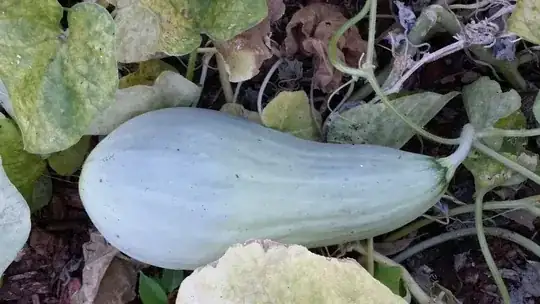Squash varieties in the same species freely cross. If you want to save your seeds for reuse, you have to grow only one variety from each species -- and hope that none of your nearby neighbors grows squash. Note that a single species can have varieties that include summer, winter, and ornamental fruit.
The shape of the fruit is determined solely by the genetics of the fruiting plant, or so my botany teacher told me. You have an unusual one because the people you got the seed from got a bee wandering in from some place that had a compatible squash of a different type. @Shule's comment above indicates that the pollen can affect the fruit. Is this odd one on a plant that has normal looking squash, or are all the squash on this plant odd. If it is a single squash, the Shule is correct, although I don't understand why yet. If they are all like that, then I suspect you had a weird seed in the packet.
As far as I know all the crosses are edible. You won't poison yourself. Some are tasteless, some have woody or stringy textures. Winter keeping will be variable.
The seeds aren't likely to breed true, but it doesn't hurt to try.
A comment asked me to list the hybridization groups. I thought there were 4 that included interspecies hybrids. There are 7 hybridization groups, 4 cucurbits and 2 cucumis, and one citrullus. Note that the species and the use do not correllate well.
From Walter Reeves web site:
Group A: Cucurbita pepo:
Summer Squash
- Crookneck, straight neck squash.
- Zuccini, Cocozelle
- Scallop, Pattypan
Winter Squash
Ornamental Gourds
(And this is why the hybrids may have odd taste/texture.
Group B Cucurbita moschata
Winter Squash
Pumpkins
- Cheese
- Dickinson Field
- Golden Cushaw
- Kentucky Field
Group C Cucurbita maxima
Winter squash
Pumpkins
- Big Max
- King of the Mammoths
- Mammoth Chile
- Mammoth Prize
- Atlantic Giant
Ornamental squash
Group D Cucurbita argyrosperma (formerly mixta)
Pumpkins
Green-Striped Cushaw
Japanese Pie
Tennessee Sweet Potato
White Cushaw
Mixta Gold
Group E Cucumis sativus
- All slicing and pickling Cucumbers (except Armenian cucumber):
- Beit Alpha cucumber
- Lemon cucumber
Group F Cucumis melo
Cucumbers
- Armenian (Snake cucumber or Serpent melon)
Melons
- All muskmelons
- Casaba
- Honeydew
Group G Citrullus lanatus
- All watermelons
- All citrons
